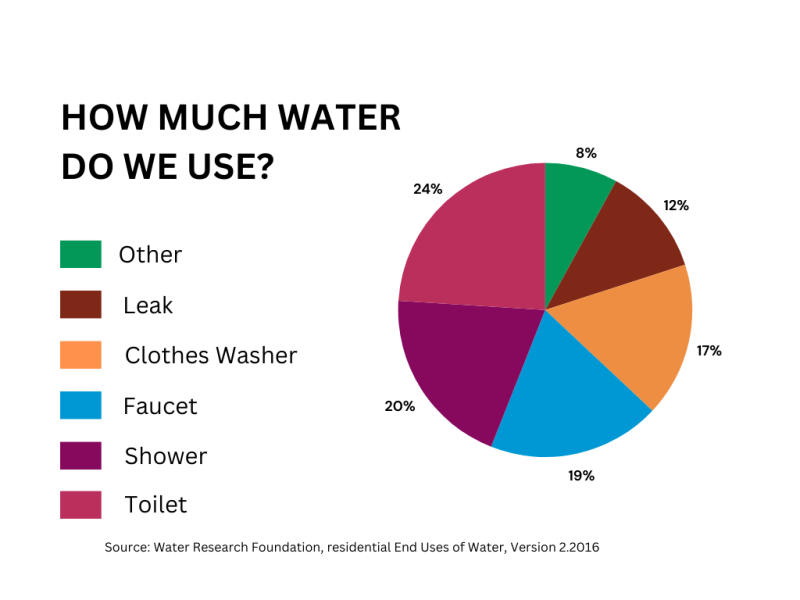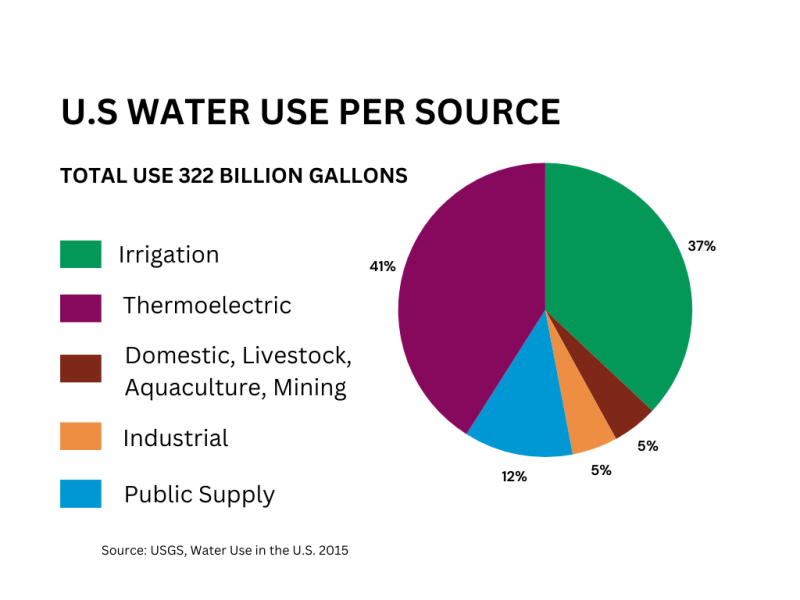Water Conservation
Reduction Strategies
The interconnection of water bodies and human use relies on each of us to take consideration of our actions and subsequent impacts. Figure out you can minimize your impact in the following subjects!
Our world is filled with water. Clean and readily available water is often taken for granted by a majority of the U.S. because of this fact. The reality is that about 3 percent of Earth’s surface is freshwater, with 1 percent of that water being available for human use. With water shortages to be expected in 40 states around the US by 2024. Every single gallon used by humans becomes altered before returning to our watershed, and reduces the volume in our lakes, springs, rivers, streams, and aquifers. With this picture it is far easier to understand the care necessary to retain the quality of water that human life and societal processes are dependent on. Conserve our surface and ground water quality with the reduction strategies below:


Additional Resources
Minimize Your Impact
From protecting fish habitat through riparian buffers, to a well-developed rotational grazing system; applying best management practices preserves our natural resources. Working the land is a tradition and boon in our county. This boon needs to be protected from misapplication to promote community viability and environmental protection. As such, Thurston Conservation District (TCD) provides education, technical, and financial assistance to conserve and sustain the beneficial use of our natural resources.
Find how to improve your management of natural resources here: Resource Library – TCD
The U.S. Department of Agriculture has many great resources as well: Conservation Resources for Farmers and Landowners | Farmers.gov
Pet waste is a health risk to people, especially children. It is full of bacteria, worms, and pathogens that can make people sick if not cleaned up and properly disposed of. Landfills are designed to handle pet waste safely. Yards, trails, streets, parks, toilets, and compost piles are not. Remember to take a non-plastic bag with you on walks or use the dog waste stations in common areas. At home, daily pick up is best.
Why can I not let my pet's waste break down naturally?
There are three key reasons: pathogen lifespan, rain, and quantity.
Lifespan
Even though the solids may dissolve, pathogens and other contaminants can be washed into the nearest storm drain or waterway. Even if it does eventually decompose, the pathogens it carries may not go away for several years – they can make you and your children sick and even cause swimming and shellfish closures.
Some of these organisms can even survive in the soil for years. Children who play in the yard and adults who garden are most at risk of infection. through this pathway.
Rain
When it rains, harmful bacteria from pet waste travels to nearby streams and storm drains. If it's washed through storm drains and into a lake, stream or Puget Sound, the bacteria can end up in fish and shellfish. People who eat contaminated shellfish or drink the water can get very sick.
Quantity
No watershed is naturally prepared to accommodate the amount of waste produced by domesticated dogs. Imagine a city of over 30,000 people all using their backyards as bathrooms.

It is best for your system to use less water. The more wastewater you put down the drain, the more liquid the system must treat and dispose of.
To reduce your water use:
- Use water saving devices on your showerheads, toilets, and faucets.
- Repair leaking faucets and plumbing features. A leaking faucet can be slow or hard to see but can add up to hundreds of gallons of extra water for your system.
- Don't leave the water running when brushing your teeth or washing your hands.
- Take shorter showers.
- Only run the laundry machine or dishwasher when it is full. If your laundry machine has load size settings, use the correct load size for laundry you add.
Additional Resources:
Other conditions that put added stress on the system include the arrival of an infant or extended holiday visits from relatives or friends. Consider having the system inspected more often during times of high use and pump as often as needed.
A dye test is a diagnostic tool used to identify septic systems that are leaking sewage into the environment instead of the established drainfield. This tool does not catch every broken septic system. Specific soil, water, and topographical conditions need to be combined with component failures to expose dyed sewage to the surface. Following proper operation, maintenance, and inspection of your system is the best method to ensure the longevity of your septic system, while protecting Thurston County’s residents and environment. With that said, dye tests can and do reveal failing septic systems.
The Process
Staff will come to your site once a week, over the course of four weeks to establish and replace monitoring sites. On the second visit, members of our staff will need to enter your household to pour dye into your plumbing fixtures. Each visit normally takes less than thirty minutes. A full outline of the process is detailed below:

- Week 1: Background Evaluation
Our staff come to your property and identify locations where charcoal packet will be placed to monitor water movement. These locations are low spots on the parcel where liquid appears to flow, surface, or leach, in order to capture dye that may leak during the performed test. This week is performed prior to our staff introducing dye – to reveal if any dye is naturally present in the environment. - Week 2: Dye Poured
“Background” charcoal packets are replaced with a new set prior to our staff entering your home to pour the non-staining dye into your plumbing fixtures (e.g., toilet and sink). Fifteen minutes is the typical length of the process for our staff to complete the process. After which, staff will no longer need to enter your residence. - Week 3:
Charcoal packets are removed and replaced with a new set. - Week 4:
Charcoal packets and any equipment used to mark or affix these packets is removed. Our staff will no longer need to be on site. Any further communication will be provided through the means agreed upon. - Lab Processing:
Charcoal packets are processed in our laboratory to detect if the dye poured into the house plumbing fixtures was detected. If dye is found, samples are sent to an outside laboratory to substantiate the presence of the dye. - Results
After the lab has finished processing the charcoal packets, our team will notify you of the results.
A handout outlining the process will be given to you prior to starting. You can find an online version here – Dye Test Process
Rainfall falls on the surface collecting everything that is left behind from our human activities. This water flows across the human altered landscape and into our public network of stormwater systems prior to returning to a waterbody. Each of us can play a role in safeguarding this water throughout its journey. Follow the tips below to help improve our county:
- Only rainfall should enter a storm drain or drainage ditch. Never dump or dispose of anything into this system.
- Properly dispose of all trash and solid waste. This includes cigarette butts, do not throw them on the ground.
- Clean up after your pet. Pet waste contains bacteria, viruses, and worms that can transmit diseases to humans.
- Instead of a typical lawn, consider replacing the area with native plants, a rain garden, thick vegetation, or trees. The layout change can help reduce, slow, and even filter stormwater.
- Do not exceed agronomic rates in the application of fertilizers or pesticides and only use when needed.
- Help keep storm drains, swales and ditches free from fill and cover.
- Ensure your car receives properly maintenance. Leaking oil, gasoline, or solvents can cause extreme harm to wildlife. Even washing your car can pollute nearby waterbodies with oils or greases. Take your car to a commercial car wash or perform your cleaning in the grass.
- Educate your friends and family to promote community response in protecting our waterways.
If you are looking for more information and practical measures you can install, be sure to take a look at New Hampshire’s Department of Environmental Services Homeowner Guide – Homeowner's Guide
Contact the Water Quality Laboratory at 360-867-2631 or email us at environmental_health@co.thurston.wa.us if you have additional questions. Biotoxin Hotline: 1-800-562-5632




